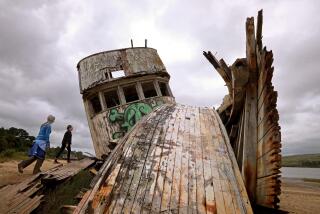Kitty Hawk Pulling Out for the Last Time
- Share via
“The Hawk,” that cumbersome gray aircraft carrier that has been a part of the Coronado skyline for a quarter of a century, sails away forever this morning, never to return.
“Never” and “forever” are words the Navy does not use, but even the Navy admits that old CV 63, the Kitty Hawk, won’t be coming back “in the foreseeable future.” The 80,000-ton behemoth, which once was the terror of the Pacific, will leave its moorings off North Island Naval Air Station at 10 a.m. with about 5,300 sailors and airmen aboard. When it passes by the Point Loma lighthouse, it is headed for an around-the-world tour of duty from which it will not return.
The ship, which was commissioned in April, 1961, and arrived here in November, 1961, will leave behind a monument to its existence--Shelter Island. The man-made spit in San Diego Bay, which has since blossomed with tourist hotels, yacht anchorages and posh restaurants, was created from the bottom mud dredged for a 42-foot-deep, three-mile channel through the bay, needed for the Kitty Hawk to negotiate the distance from the harbor entrance to its North Island moorings.
After a meandering six-month journey around the world, showing the flag through three oceans and several seas, the carrier will arrive in Philadelphia in July for a three-year face lift valued at somewhere between $750 million and $850 million. The overhaul will add 25 years to its life.
Then the Vietnam veteran, refurbished, will move to a new home port at Pensacola, Fla., in 1991, probably not returning to the Pacific. The carrier Independence (CV 62) will replace the Kitty Hawk in San Diego after it completes its renovation in Philadelphia naval shipyards and undergoes a shakedown cruise in 1988.
In 1990, another of San Diego’s aircraft carriers, the Constellation or the Ranger, is headed for Philadelphia for the same expensive overhaul. But those craft are expected to return to Pacific duty and to San Diego.
During its lifetime, the Kitty Hawk has been a bellwether for the moods of the United States. Its 87 high-performance aircraft flew 10,000 missions in the Vietnam War and the ship has made 15 major tours of duty during its 25 years of service, six to Vietnam. It has also served time in the Indian Ocean during crises in Iran and Afghanistan, and been on rescue tours off the coast of Indochina, rescuing boatloads of refugees.
In 1967, 11 crew members were arrested in Pearl Harbor and discharged from the service for using marijuana--one of the Navy’s first crackdowns against drug use.
The Kitty Hawk became infamous as a symbol of anti-Vietnam sentiment in the United States when, in 1972, anti-war activist Joan Baez led a protest here against the San Diego carrier’s prominent part in the war. The anti-war fever prompted seven Kitty Hawk sailors to desert and seek refuge in local churches when the ship sailed again for the war zone. But the AWOL sailors were arrested and flown back to their ship by military helicopters, quelling the incipient anti-war protest.
A few months later, a pitched battle of black seamen against white was fought at sea off the coast of Vietnam. The Kitty Hawk Riots, which military leaders said were caused by the perception that poor, black Americans were drafted in greater numbers than were whites, simmered for months, erupting again and again in lesser fights aboard ship and in port.
The Kitty Hawk made international headlines in 1984 when it sideswiped a Soviet nuclear-powered submarine that apparently surfaced in its path in the Sea of Japan off South Korea. Neither craft sustained critical damage and the sub limped away with a Soviet cruiser as escort.
In 1985, a Navy storekeeper blew the whistle on Kitty Hawk brass for allowing widespread fraud, theft and waste in accounting procedures aboard the ship. The charges were turned into a national scandal when Rep. Jim Bates (D-San Diego) initiated congressional hearings. The charges included claims that crewmen threw excess furniture and parts overboard instead of filling out the cumbersome paper work required by the military to transfer the unneeded equipment off the ship. The disappearance of more than a dozen bars of silver from the ship’s stores spiced the tale of mismanagement.
But San Diego is a Navy town, where every 10th citizen is in the Navy or is a dependent, a Navy employee or a retired Navy veteran. The Kitty Hawk, San Diego’s first and finest aircraft carrier, is expected to be ushered out of town with as much ceremony as it arrived with.
In November, 1961, an estimated 20,000 residents greeted the big ship when it first sailed into the harbor and that many residents and dependents are expected to see her depart this morning from vantage points on North Island, Point Loma and Shelter Island.
More to Read
Sign up for Essential California
The most important California stories and recommendations in your inbox every morning.
You may occasionally receive promotional content from the Los Angeles Times.










